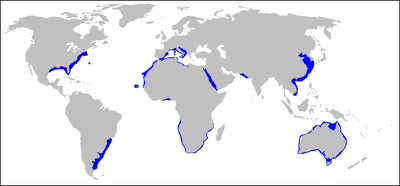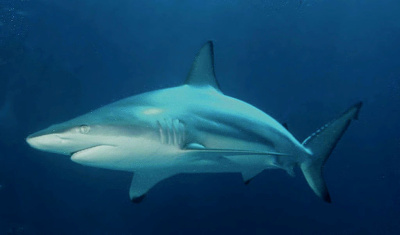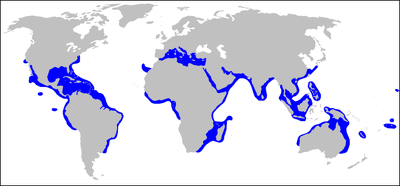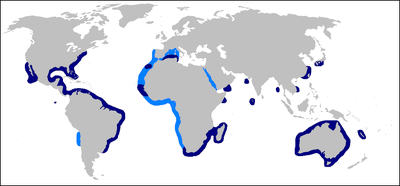Home | Category: Shark Species
COASTAL SHARKS
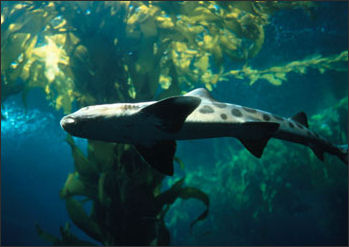
leopard shark The waters off the East Coast of the United States are home to more than 50 shark species. These range from the small spiny dogfish to the much larger white shark, and they are found in just about every kind of ocean habitat. Most Atlantic sharks spend at least part of their lives in coastal waters. Many species move through bays and estuaries along the U.S. coast in search of food. Others are open-ocean dwellers that use shallower waters as nurseries or occasional feeding grounds. English NOAA]
Species like Atlantic blacktip, spinner, and Atlantic sharpnose sharks can be abundant in the Southeast’s and Gulf of Mexico’s nearshore waters. In the Caribbean Sea, tiger, hammerhead, and Caribbean reef sharks are often seen. In the Mid-Atlantic region, sandbar, sand tiger, and smooth dogfish sharks frequent nearshore waters, especially during the summer. These species are also found in New England waters, where spiny dogfish and white sharks commonly swim in search of their natural prey.
At least 34 species of sharks have been recorded off the Pacific Coast of North America.
They includes the spiny dogfish, combtooth dogfish, lollipop catshark, peppered catshark, silvertip shark, bignose shark, copper shark, silky shark, Galapagos shark, bull shark, blacktip shark, oceanic whitetip, dusky shark, sandbar shark, smalltail shark, whitenose shark, lemon shark and blue shark. [Source: Shark Research Committee]
Leopard sharks ((Triakis semifasciata) have distinctive black spots on their sides and fins. Similar to about six other species and found in the eastern Pacific in kelp forests and around reefs, it reaches lengths of about 2.1 meters and weighs around 32 kilograms and uses its relatively small, sharp teeth to grab a wide variety of prey, including burrowing invertebrates whose exposed parts the shark quickly snags. According to the International Shark Attack Files one non-fatal attack has been attributed to this species.
Related Articles: COPPER SHARKS (BRONZE WAILERS): CHARACTERISTICS, BEHAVIOR AND REPRODUCTION ioa.factsanddetails.com ; OPEN OCEAN SHARKS: BLUE SHARKS AND OCEANIC WHITETIP SHARKS ioa.factsanddetails.com; SHARKS AND RAYS ioa.factsanddetails.com; HUMANS, SHARKS AND SHARK ATTACKS ioa.factsanddetails.com; SHARKS: CHARACTERISTICS, SENSES AND MOVEMENT ioa.factsanddetails.com ; SHARK BEHAVIOR: INTELLIGENCE, SLEEP AND WHERE THEY HANG OUT ioa.factsanddetails.com ; SHARK SEX: REPRODUCTION, DOUBLE PENISES, HYBRIDS AND VIRGIN BIRTH ioa.factsanddetails.com ; SHARK FEEDING: PREY, HUNTING TECHNIQUES AND FRENZIES ioa.factsanddetails.com
Websites and Resources: Shark Foundation shark.swiss ; International Shark Attack Files, Florida Museum of Natural History, University of Florida floridamuseum.ufl.edu/shark-attacks ; Animal Diversity Web (ADW) animaldiversity.org; National Oceanic and Atmospheric Administration (NOAA) noaa.gov; Fishbase fishbase.se ; Encyclopedia of Life eol.org ; Smithsonian Oceans Portal ocean.si.edu/ocean-life-ecosystems
Requiem Sharks
Requiem sharks are sharks of the family Carcharhinidae in the order Carcharhiniformes. They are migratory, live-bearing sharks of warm seas (sometimes of brackish or fresh water) and include such species as the bull shark, tiger shark, silky shark, dusky shark, spinner shark, blacknose shark, lemon shark, blacktip shark, grey reef shark, blacktip reef shark, blue shark, copper shark, oceanic whitetip shark, and whitetip reef shark.
Many requiem sharks look similar and are difficult to tell apart. Grey reef sharks (Carcharhinus amblyrhynchos), for example, can be easily mistaken for similar species of requiem sharks. The blacktip shark (Carcharhinus limbatus) and the blacktip reef shark (Carcharhinus melanopterus) can be distinguised by a black tip on the dorsal fin, while the dorsal fin of C. amblyrhynchos is white or grey. Similarly, the silvertip shark (Carcharhinus albimarginatus) has white tips on its pectoral and caudal fins, while the grey reef shark does not. [Source: Animal Diversity Web (ADW)]
Requiem sharks are among the top five species involved in shark attacks on humans; however, due to the difficulty in identifying individual species, a degree of inaccuracy exists in attack records. Requiem sharks (Carcharhinus spp.) have accounted for 46 non-fatal attacks and 5 fatal attacks for of total of 51 attacks. [Source: International Shark Attack Files, Florida Museum of Natural History, 2023, Wikipedia]
According to International Shark Attack Files: Due to the similarity of small coastal species in this group in tooth shape, body size, and appearance, it is often difficult to assign a species in bite cases. Based on life history traits, ISAF suspects blacktip sharks (C. limbatus) account for the majority of these requiem bites in Florida. However, these cases lack enough evidence to be conclusive.
Sand Tiger Sharks
Sand tiger sharks are fearsome-looking creatures that swim around with their mouths open, exposing rows of spike-like teeth. In reality they are generally nonthreatening. They hoover in the water by swallowing surface air and holding in their stomachs to regulate its buoyancy. Their habit of swimming with their teeth exposed is actually a benign behavior called yawning.
Sand tiger sharks reach length of 4.4 meters and weigh up to 150 kilograms and are found in the eastern and western Atlantic, southern Indian and western Pacific Oceans. Their fearsome appearance but benign behavior makes them a favorite of aquariums around the world.
Sand tiger sharks have a large mouth and dorsal fins that are situated further back than on most sharks. They have light brown or beige and darker brown, somewhat tiger-like blotches scattered around its body, hence the name. They catch prey with a sneaky sideways snatch. A slow but strong swimmer, it feeds on a variety of bony fishes, squids, crabs and lobsters. Groups of them have been observed working to surround shoals of prey
Embryos are cannibalistic. The first to hatch eat the other eggs inside the egg case. Survivors grow teeth and eat other embryos in the uterus. Generally only one baby shark emerges alive from each of the shark’s two uteri.
Sand tigers (Carcharias taurus) have accounted for 36 non-fatal unprovoked attacks and 0 fatal attacks for of total of 36 attacks. [Source: International Shark Attack Files, Florida Museum of Natural History, 2023]
Within their genus,, blacktip reef shark and sand tiger shark females illustrate their readiness to mate by reducing their speed and swimming with their tails in a more upward position and their snout pointing slightly down. The male will then come up to the female and place its snout below the female’s vent.
Blacktip Sharks— the Minor Shark Bite Kings
Blacktip sharks (Carcharhinus limbatus) have been implicated in a number of shark attacks, many of them minor and many in Florida where the sharks chase huge schools of baitfish close to shore where their paths intersect with those of human swimmers. According to the International Shark Attack Files, Florida Museum of Natural History, they accounted for 35 non-fatal unprovoked attacks, a fairly high number, and zero fatal attacks, .
Blacktip sharks are likely responsible for the majority of bites in Florida, which has consistently had the highest bite count of any geographic area for the past several decades. Blacktip sharks bit 28 people between 1958 and 2019 (the majority in Florida). All but one resulted in relatively minor, and non-fatal, bites. These relatively small sharks hunt in warm waters near shorelines where they use the shallows to avoid predators of their own, including great hammerheads (Sphyrna mokarran) and bull sharks (Carcharhinus leucas). [Source: Jerald Pinson, Shark Files, Florida Museum of Natural History, January 24, 2022
Also known as the black fin shark, blacktip whaler, common blacktip shark, gray shark, requiem shark, small blacktip shark and spot-fin ground shark, the beige-colored blacktip shark has a sharp, pointy snout, a white underside and fins have black tips. They reach lengths of two meters (6.5 feet) and are found in New England, the Mid-Atlantic and the Southeast of the U.S. They are common from Virginia through Florida and migrate as far north as Cape Cod, Massachusetts. The Atlantic blacktip shark is primarily a continental shelf species. They’re commonly found off beaches, in bays, estuaries, over coral reefs, and off river mouths. They can also be found around some oceanic islands..
Blacktip sharks are a popular recreational species because they are found near shore and often jump and spin out of the water. U.S. wild-caught Atlantic blacktip shark is a smart seafood choice because it is sustainably managed and responsibly harvested under U.S. regulations. Above target population levels exist in the Gulf of Mexico and the Atlantic. Regulations are in place to minimize bycatch.[Source: NOAA] There are two stocks of blacktip shark: Gulf of Mexico and Atlantic. According to the most recent stock assessments both are not overfished and not subject to overfishing
Blacktip Sharks Characteristics and Behavior
Blacktip sharks are gray to gray-brown, with white on the belly and a conspicuous wedge-shaped band or Z-shaped line on the sides. Their bodies have a torpedo shape, which allows them to swim through the water with little effort. Their pectoral, dorsal, and tail fins have black tips, but the anal fin is white.
Atlantic blacktip sharks are often confused with spinner sharks due to their similar size, shape, coloration, and behavior. Both species are known for leaping and spinning out of the water while feeding on schools of fish. A distinguishing feature is that the anal fin on the blacktip shark is white whereas the anal fin of the spinner shark has a black tip.
Atlantic blacktip sharks grow quickly. The oldest observed blacktip shark was 15.5 years old. They often form large groups, segregated into separate schools of males and females when they are not mating. They mate between March and June. Males mature at 4 to 5 years of age, while females mature later, at 6 to 7 years of age.
Females have an 11- to 12-month gestation period and give birth to an average of three pups per litter in the Atlantic and four to five pups per litter in the Gulf of Mexico. Pups are born in shallow nursery grounds away from the adult population. After giving birth, the females leave the nursery area while juveniles remain.
Dusky Sharks
Dusky sharks (scientific name: Carcharhinus obscurus) are among the more plentiful and at the same time overfished sharks. They frequently follow ships and are the species most often found entangled in anti-shark nets off South Africa's beaches. Dusky shark numbers are estimated to have declined by 72 percent between 1975 and 2020. [Source: Mónica Serrano and Sean McNaughton, National Geographic, July 15, 2021]
Adult dusky sharks have very few predators other than humans and other sharks. Young ones are at risk of being preyed upon by larger sharks in the area, but as they grow this threat disappears. Humans catch them to eat and for their fins. [Source: Justin Alouf, Animal Diversity Web (ADW) /=]
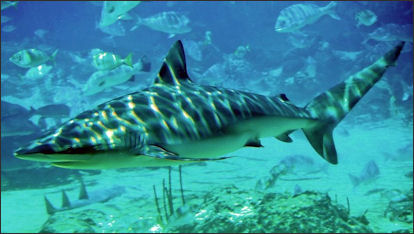
Dusky shark Dusky shark are described as generalists, preying on a wide variety of animals. They are an apex predator in their system. Their lifespan in the wild is around 40 years. There are some indications they can reach the mid-40s to 50s. These shark can be extremely aggressive. There have been several reports of them attacking humans but some were provoked. According to the International Shark Attack Files, Florida Museum of Natural History, dusky sharks have accounted for one non-fatal unprovoked attack on humans and one fatal attack for of total of two attacks.
Dusky sharks typically feed close to the sea bottom. Juveniles tend to prey on smaller prey such as sardines and small squid. Adults hunt for larger prey such as groupers. Dusky sharks also eat skates, rays, sea turtles, other sharks, gastropods, crustaceans, and sea stars. They can sometimes mistakenly consume human trash. Bottlenose dolphins have turned in their stomachs but they believed to have been already dead when they were consumed. There is a report of dusky sharks attacking a humpback whale calf.
Dusky Shark Habitat and Where They Are Found
Dusky sharks live in temperate, tropical, saltwater and marine environments. They are found in coastal areas and the open ocean at depths of zero to 400 meters (1312 feet), with the average depth being 40 meters (131 feet). Dusky sharks are commonly seen in tropical coastal waters. They appear in temperate environments when they are migrating. The depths that they occupy depend on the environment they are in at the time. When swimming near the coast, they tend to stick around depths ranging from 50 to 100 meters. In the southern Gulf of Mexcio gulf waters they tend to stay at depths of 20 to 50 meters. [Source: Justin Alouf, Animal Diversity Web (ADW) /=]
Dusky sharks are widely distributed over large and diverse geographic range in the Indian Ocean, Atlantic Ocean, Pacific Ocean and Mediterranean Sea. They are a predominately coastal species. There are large populations of dusky sharks off the coasts of Australia. They have also been seen near Bangkok, Thailand and Hong Kong, China, as well as off the eastern coast of Japan. In western Indian Ocean they live around all of Madagascar, locations off the coast of Mozambique, the eastern southern tip of Africa. They are also regularly observed in the Red Sea.
In the eastern Pacific Ocean they are often seen from the southern tip of California going southward along the western coast of Mexico at Guadalajara. Some populations live in areas on the western coast of Chile. In the eastern Atlantic Ocean they are found along the western coast of Portugal and entire coast of west Africa. In the Mediterranean Sea they have been spotted on the eastern coast of Spain and the northern coast of Algeria. Along the east coast of North America they reside in waters from the Texas-Mexico border of the Gulf of Mexico, eastward through the western coast of Florida and the northern coast of Cuba. They also inhabit the eastern coast of North and South America,
Dusky Shark Characteristics and Behavior
Dusky sharks range in length from 74 centimeters to 4.2 meters (2.4 to 13.75 feet) and range in weight from 160 to 450 kilograms (352. to 991 pounds), with their average weight being 180 kilograms (396.5 pounds). Females are slightly larger than males. Adult females typically range from 76 centimeters to 2.9 meters (2.4 to 9.5 feet) in length, while males range from 74 centimeters to 2.8 meters (2.4 to 9.1 feet) long. Length at sexual maturity is around 2.35 meters (7.7 feet), with a range 2.2 to 3 meters (7.2 to 10 feet). The largest dusky shark on record was 4.20-meter (13.7-foot) male. The heaviest was a pregnant female weighing 450 kilograms (991 pound). At birth, dusky sharks are 48 to 100 centimeters in length. . [Source: Justin Alouf, Animal Diversity Web (ADW) /=]
According to Animal Diversity Web: As their name suggests, dusky sharks have dusky tips on their fins that are not very prominent. Their undersides are white and their snouts are rounded. Their pectoral fin is in the shape of a sickle. They are known to have the strongest bite of any shark species, being able to produce 60 kilograms of force when their jaws are fully closed. Adding to this bite force, their teeth are sharp, in the shape of a triangle, and serrated on both exposed sides. /=\
Dusky sharks are motile (move around as opposed to being stationary) and migratory (make seasonal movements between regions, such as between breeding and wintering grounds). They communicate with vision, touch, electric signals and chemicals usually detected by smelling and vibrations and sense using vision, touch, vibrations, chemicals detected by smelling and electric signals. They don't have a reported home range, nor do they defend a territory. They are known to follow ships.
Dusky sharks migrate from location to location depending on the temperature and season at the time, trying to stay in the more tropical areas during all times of the year. The females move closer to the shore when they are about to give birth, then move away from shore afterwards. The pups typically form schools that are sometimes divided up between males and females and hunt together. As they get older, they move away from the shore to more open waters but still moderately close to the shore.
Dusky Shark Mating, Reproduction and Offspring
Dusky sharks are viviparous (they give birth to live young that developed in the body of the mother) and iteroparous (offspring are produced in groups such as litters). They engage in seasonal breeding and are able to mate every three years. There is no information on the time of year mating occurs. Dusky shark are polygynous (males have more than one female as a mate at one time). [Source: Justin Alouf, Animal Diversity Web (ADW) /=]
The gestation period for female dusky sharks range from 16 to 22 months. After they give birth female dusky sharks have to wait a year before mating again, making their overall reproduction cycle three years long. Females reach sexual maturity at 17 to 24 years, usually around 21 years old, and males reach sexual maturity between 17 to 24 years old, usually around age 19 years (. Their late sexual maturity and slow reproductive rate are reasons why they take so long to recover after they have been overfished
Dusky shark females have litters ranging from 3 to 14 pups in one litter, with each pup ranging from 70 to 100 centimeters (2.3 to 3.3 feet) in length but can be as small as 48 centimeters (1.6 feet). Pups are nourished from a yolk-sac and placenta. When the yolk sac runs out of nutrients, the placenta then feeds the young. Late term females lack a large yolky ova — one reason why they have to wait a year to mate again.
Dusky shark young are born with an oversized liver that accounts for 20 percent of the pups mass at birth. The liver contains stored energy for the pups to use within the first months of their lives. After the stored energy is used up, they are able to hunt and live freely.
Paternal investment is minimal among dusky sharks. Pre-birth, pre-weaning and pre-independence parental care is provided by females. After impregnation, males have nothing to do with the pups. The post-independence period is characterized by limited association of offspring with their mother. Immediately after birth, the mother moves away from the pups to avoid cannibalism and pups remain in a group shortly after birth. Pups are born with working jaws and teeth and are able to hunt and kill from the time of birth. It has been suggested however that although they do not stay with the mother, the pups are not totally independent because they are initially dependant on their their mothers providing them nutrients within their liver to survive after birth.
Dusky Sharks, Humans and Conservation
Humans utilize dusky sharks them for food and ecotourism. Their body parts are sources of valuable materials and medicines. Their meat has traditionally fetched high prices and their fins are valued for shark fin soup. Their skin used as leather. Oil from their livers has been exploited as a source of vitamins. They are also the subject to ecotourism in many areas because of their tendencies to live near coastal waters. [Source: Justin Alouf, Animal Diversity Web (ADW) /=]
The International Union for Conservation of Nature (IUCN) Red List lists disky sharks are : “Vulnerable.” They have no special status according to the Convention on the International Trade in Endangered Species (CITES). Ebert et al. (2013) list them as Endangered in the northwest and central Atlantic ocean.
Dusky sharks have been severely overfished. Many have been caught as by-catch in tuna nets. The number of them caught fell from around 2,800 metric tons in 1981 to around 350 metric tons in 2000. In the 2000s, 144,000 to 767,000 dusky shark fins were traded each year. Some scientists believe it will take 100 years to 400 years for them to recover. Their late sexual maturity and slow reproductive rate are reasons why they take so long to recover after they have been overfished
It is now illegal to fish or kill dusky sharks in the United States. The ban on fishing them in the U.S. Atlantic has helped their populations improve somewhat. In other areas, the ban hasn't been effective. In 2003, despite the ban, over 2000 dusky sharks were harvested. Various efforts by other countries and international conservation groups have been undertaken for dusky sharks and other sharks — but implementation has been slow.
Image Source: Wikimedia Commons, NOAA
Text Sources: Animal Diversity Web (ADW) animaldiversity.org; National Oceanic and Atmospheric Administration (NOAA) noaa.gov; Wikipedia, National Geographic, Live Science, BBC, Smithsonian, New York Times, Washington Post, Los Angeles Times, The New Yorker, Reuters, Associated Press, Lonely Planet Guides and various books and other publications.
Last Updated March 2023


